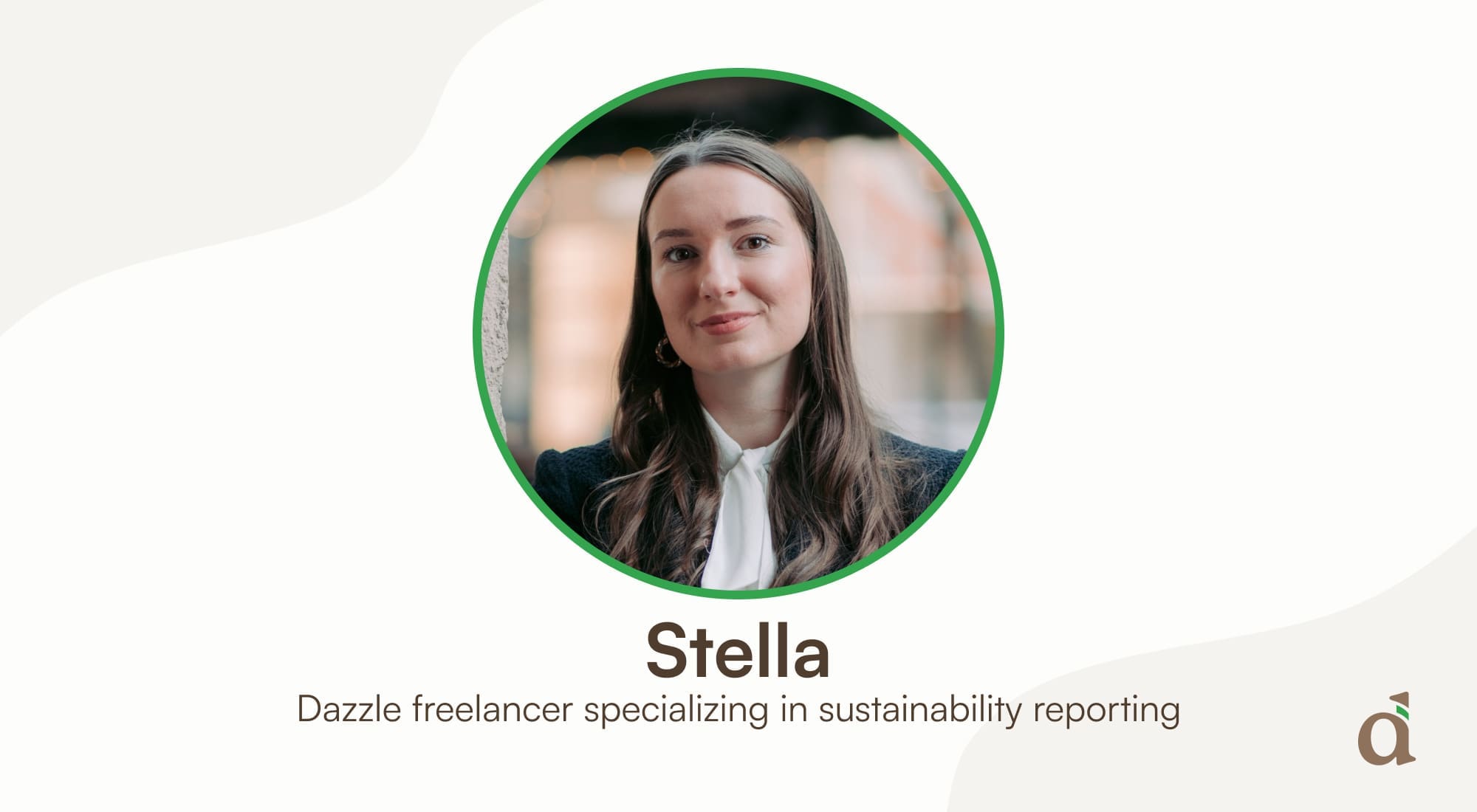About the author
With a Master’s degree in Leadership for Sustainability from Malmö University, Stella brings deep expertise in turning sustainability ambitions into actionable business strategies. Her experience spans major clients, including from sectors such as aviation, marine transport, manufacturing, healthcare, gaming, and trading, giving her a clear understanding of how SMEs fit into global value chains.
She played a key role in creating the first ESRS-aligned sustainability reports in Croatia and has delivered numerous corporate ESRS training sessions. As a certified VSME expert and active member of the EFRAG’s VSME Community, she contributes to shaping guidance and support systems for SME sustainability reporting across Europe.
She specializes in leading SMEs through their sustainability transformation – helping them build future-ready ESG strategies, implement effective sustainability management systems, and publish high-quality sustainability reports aligned with global standards.

1. What is the VSME standard?
The VSME standard is a framework developed by the EU, and is designed to assist small and medium-sized enterprises (SMEs) in reporting on their sustainability performance and ESG data disclosures. VSME (Voluntary Sustainability Reporting Standard for Small and Medium-sized Enterprises) is for companies that are not subject to mandatory sustainability reporting (i.e. out of the CSRD scope), and allows them to fulfill the growing number of requests for sustainability information.
There are two types of preparers of the sustainability report – those who report voluntarily based on their own business strategy, and those that face requests on sustainability from stakeholders (mainly customers and investors).
Businesses that are selling sustainability-oriented products and services, that are active in green B2B or B2C markets, or that focus on solving sustainability issues, can benefit from VSME reporting as it:
- Helps to strengthen their brand by highlighting sustainability wins.
- Differentiates them from competitors and opens access to new market opportunities.
- Aids in standardizing and structuring ESG information.
On the other hand, there are many SMEs that engage in ESG disclosures in response to a demand for information that originates from their value chain, or from financial institutions that need to fulfil regulatory requirements themselves. In this case, preparing a VSME report helps SMEs to:
- Successfully meet demands from business partners.
- Access green procurement opportunities and investment funds.
- Improve their sustainability management and reduce the need for ad hoc data collection.
Whether motivation is internal or external, both groups of SMEs will benefit from development of the VSME report. This article explains the basics of VSME reporting and outlines the steps in the process.
🌍 Why choose the VSME standard for your sustainability report?
The VSME standard, developed by EFRAG, is gaining strong support at the EU level. As recently as 30th July 2025, the Commission recommended that non-listed SMEs and micro-undertakings that wish to voluntarily report sustainability information should do so in accordance with the VSME standard developed by EFRAG. Additionally, the Commission recommends that Member States take appropriate measures at national level to foster the implementation and acceptance of the voluntary sustainability reporting standard for SMEs.
This means that SMEs looking for a reliable, EU-aligned reporting framework should strongly consider using the VSME standard. It is designed to simplify sustainability reporting and promote consistency across all EU member states.
VSME is the EU’s preferred path for voluntary sustainability reporting – clear, practical, and future-ready.

2. Key features of the VSME standard
VSME structure
The VSME standard consists of two modules:
(a) Basic module: Disclosures B1 and B2 and basic metrics (B3 to B11). This module is the target approach for micro-undertakings and constitutes a minimum requirement for other undertakings.
(b) Comprehensive module: This module sets datapoints in addition to disclosures B1-B11, which are likely to be requested by banks, investors, and corporate clients of the undertaking on top of the basic module.
The basic module is a necessary prerequisite for using the comprehensive module, meaning SMEs should look at it as the “foundations” of their sustainability report, while the comprehensive module is an “upgrade”. Note that when SMEs choose their approach to reporting they must comply with all disclosure requirements of the chosen module to ensure compliance with the VSME standard.
“If applicable” principle
The VSME standard follows the “if applicable” principle, meaning that SMEs need to provide ESG data and information on disclosure requirements only if it is relevant to the company’s business model and operating context. The standard provides clear instructions about which disclosures the “if applicable” principle applies to. If a disclosure requirement is not applicable and thus omitted from the report, it is considered that there are no major sustainability risks related to that area. This is important from the perspective of sustainability report users such as investors or customers.
Example: “If applicable” principle in case of B7 – Resource use, circular economy and waste management disclosure requirement
Under disclosure requirement B7, the undertaking shall disclose:
(a) The total annual generation of waste broken down by type (non-hazardous and hazardous).
(b) The total annual waste diverted to recycling or reuse.
(c) The annual mass flow of relevant materials used (this is applicable if the undertaking operates in a sector using significant material flows, for example manufacturing, construction, or packaging).
While it is expected that all SMEs generate some kind of waste which can be diverted to recycling or reuse, not all SMEs require a significant amount of inflow resources to create their products and services. This makes requirement B7 (c) a subject to the “if applicable” principle. Let’s have a look at the two examples below.
SME A
SME A is a packaging manufacturer which procures three main types of materials to create boxes and shopping bags: paper cardboard, bio-plastics and fossil-based plastic. In the manufacturing process there is a surplus of the material used to create products. This surplus is sent to recycling in a specialized company and returned in the form of material to generate new products. In this case SME A should report on B7 (a), (b) and (c) disclosure requirements as they are applicable to its business model.
SME B
SME B on the other hand is a wholesaler of paper and cardboard packaging. SME B procures packaging from SME A and supplies it to retailers. SME B does not use materials in its business model. And therefore, in this case, disclosure requirements B7 (c) on material flows is not applicable. But as SME B generates waste in the warehouses related to logistics of the procured goods, disclosure requirements B7 (a) & (b) are still applicable.
Voluntary ESG discolures beyond core requirements
The VSME does not exclude the possibility to include additional ESG data and sustainability information, which allows SMEs to report on positive impacts not covered by disclosure requirements in basic and comprehensive modules. This option allows SMEs, depending on their specific issues, to integrate relevant information and ensure a more representative and reliable sustainability report. In fact, SMEs are encouraged to include additional sustainability information, especially when it helps capture positive impacts not covered in the standard modules.
Example
SME X is an active member of the local community which provides financial and in-kind support to local sport clubs and artists. It also engages in corporate volunteering activities organized by an environmental NGO. Basic and comprehensive modules do not provide space for reporting these positive impacts on the community, however, SMEs can decide to include additional information in the sustainability report, for example:
- Total amount of donations and sponsorships (financial and in-kind).
- Total number of volunteering hours by employees.
- Total number of organizations and projects supported.
VSME categories and disclosure requirements
The VSME standard is divided into 4 categories:
- General information.
- Environmental (E).
- Social (S).
- Governance (G).
The basic module consists of 11 disclosure requirements (DRs). This can be complemented with 9 disclosure requirements from the comprehensive module. While the disclosure requirements set requests for ESG data, guidance provides additional information on the context, methodology, and additional resources/tools that can be used to fulfil each requirement.
Table: VSME reporting categories and disclosure requirements
| Category | Purpose | Basic module DRs | Comprehensive module DRs |
|---|---|---|---|
| General information | Information includes basic company details and any sustainability practices, policies or future initiatives. | B1 – Basis for preparation B2 – Practices, policies and future initiatives for transitioning towards a more sustainable economy | C1 – Strategy: Business model and sustainability–related initiatives C2 – Description of practices, policies and future initiatives for transitioning towards a more sustainable economy |
| Environmental metrics | Information includes energy consumption and GHG emissions, pollution, water and resource consumption, biodiversity impacts and waste. | B3 – Energy and greenhouse gas emissions. B4 – Pollution of air, water and soil B5 – Biodiversity B6 – Water B7 – Resource use, circular economy and waste management | Considerations when reporting on GHG emissions under B3 C3 – GHG reduction targets and climate transition C4 – Climate risks |
| Social metrics | Information includes general workforce characteristics, health and safety data, remuneration and training initiatives. | B8 – Workforce: General characteristics B9 – Workforce: Health and safety B10 – Workforce: Remuneration, collective bargaining and training | C5 – Additional (general) workforce characteristics C6 – Additional own workforce information: Human rights policies and processes C7 – Severe negative human rights incidents |
| Governance metrics | Information includes details of business conduct such as any convictions or fines incurred for violating laws. | B11 – Convictions and fines for corruption and bribery | C8 – Revenues from certain sectors and exclusion from EU reference benchmarks C9 – Gender diversity ratio in the governance body |
VSME disclosure requirements allow the undertaking to provide relevant information on:
(a) How it has had and is likely to have a positive or negative impact on people or on the environment.
(b) How environmental and social issues have affected or are likely to affect its financial position, performance and cash flows.
How and where to report sustainability information?
- The VSME report can be part of the management report or a standalone sustainability report.
- The report can be published on the official website or provided upon request to stakeholders.
- The VSME report needs to be aligned with the financial reporting timeframe, and it is recommended to be prepared annually.
- When presenting information, an SME should follow 5 key principles: data should be relevant, faithfully presented, comparable, understandable, and verifiable.
Example: principles for presenting sustainability information
- Relevant
A dental care provider reports on its energy use and waste production, as these have the most significant environmental impacts for its operations, while choosing not to include land use metrics.
Why: Focuses on what is important in the context of a company’s sustainability performance, and on what matters most to stakeholders with high potential to impact their decisions related to the company.
- Faithful representation
The packaging manufacturer honestly reports a 5% increase in workplace-related accidents due to increase in overtime work, even though this reflects poorly.
Why: Ensures information accurately represents the sustainability matter. Presents a complete, neutral, and accurate picture, not just positive highlights.
- Comparable
The road transportation company discloses the same sustainability indicators (e.g. emissions intensity per km) for the last three years, using the same measurement method (e.g. same emission factors).
Why: Allows stakeholders to track progress and compare across time or with other similar businesses.
- Understandable
The apparel manufacturer uses plain language and a simple bar chart to show how much energy and materials are used each month, avoiding technical jargon.
Why: Ensures information is clear and concise, enabling comprehension. Makes the information clear and accessible to non-experts, like customers or local community members.
- Verifiable
The retailer keeps energy bills and waste disposal records, so a third party can confirm the reported numbers.
Why: Provides confidence and allows for independent verification/assurance. Ensures that the information can be checked and trusted by others.
What about assurance?
Assurance is not mandatory under the VSME standard. However, SMEs can voluntarily choose to obtain assurance, building trust and enhancing the credibility of their data. Whichever approach they choose, SMEs should ensure that reported information is accurate, reliable, and high quality.

3. How to prepare a VSME sustainability report
Creating a sustainability report doesn’t have to be overwhelming, especially with the VSME approach. Here’s a step-by-step guide to help you craft a clear, practical, and inspiring report.
Step 1: Define your goals
Why are you creating this report? Is it for customers, partners, investors, or internal use? Will it be shared publicly? Clarifying your purpose and audience early on helps you stay focused and efficient throughout the process.
Step 2: Choose the right modules
The VSME framework consists of basic and comprehensive modules.
- Just starting out? The basic module may be enough.
- Want to go deeper or meet stakeholder expectations? Add the comprehensive module.
Step 3: Consider a materiality assessment
Not required, but highly recommended. A materiality assessment helps you understand your most important impacts, risks, and opportunities, which frames your report and supports your long-term sustainability strategy.
Step 4: Gather ESG data
Based on the VSME disclosure requirements and tools and templates provided by your sustainability advisor, collect ESG data and information on your environmental, social, and governance (ESG) practices. Make sure it’s structured according to the VSME format.
Step 5: Tell your story
Numbers alone won’t connect with readers. Bring your report to life by sharing:
- Your sustainability policies and strategy.
- Real examples of ESG practices, actions, and initiatives.
- Your goals for the future.
- The story behind the data.
Step 6: Use visuals to stand out
Want your report to get noticed? Design matters.
- Use your brand colors and fonts.
- Turn data into infographics.
- Add images to break up text and boost understanding.
A visually appealing report feels more trustworthy, professional, and engaging. It also improves understanding, saves time for readers, and strengthens brand identity.
Step 7: Share and communicate
Don’t let your report sit on a shelf! Use your sustainability report as a communication tool:
- Share highlights on your website and social media.
- Include ESG messages in marketing.
- Show customers and partners what you stand for.
This boosts your market position, builds trust, and can even open new business opportunities.

4. Digitization of VSME disclosures
In order to enable the conversion of the VSME report into a digital human, and machine-readable XBRL report EFRAG has developed a Digital Template to XBRL Converter, enabling sustainability reporting in various technical formats (Inline XBRL, XBRL-XML, XBRL-JSON, XBRL-CSV). Using EFRAG’s free web platform, SMEs can automatically convert a pre-filled template (MS Excel file) into a tagged Inline XBRL report which facilitates data exchange and import to databases. Regardless of current limitations, this digitization effort by EFRAG has a positive impact on standardization and use of ESG data in the EU.
- Structured data allows investors, regulators, and the public to interpret and act on ESG data more easily.
- Digitized disclosures standardize how information is reported, making it easier to compare across companies, sectors, and regions.
- Machine-readable sustainability data enables the use of AI and data analytics tools for deeper insights and can be used for benchmarking and risk assessment, which is useful for financial institutions.

5. Why prepare a VSME-aligned sustainability report?
Small and medium-sized enterprises (SMEs) can gain real advantages by reporting sustainability information using the VSME standard. Here’s why it matters:
Boost resilience & competitiveness
- Identify areas for improvement in sustainability management.
- Benchmark performance against peers.
- Strengthen your position in the EU market.
- Attract responsible customers, the best talent, and meet green supply chain demands.
Respond to ESG data requests
- Simplify responses to growing ESG questionnaires from corporate clients and financial institutions.
- Stay ahead as large companies begin aligning their requests with the VSME standard.
- Build trust and ease collaboration across the value chain.
A standard built for SMEs
- Combines the strengths of GRI, SASB, and aligns with ESRS.
- Tailored to be simple, scalable, and proportional to SME capacities.
- Ideal for voluntary reporting without overwhelming your team.
It is important to note that VSME is a reporting, not a performance or prescriptive standard. When using the VSME standard, companies are not required to, for example, adopt a sustainability strategy, set GHG reduction targets, or invest in employee training. They are only expected to truthfully disclose current practices and data. However, the VSME standard coupled with other tools can serve as a guidance in improving sustainability management and ESG impacts. VSME reporting isn’t just a box to check, it’s a smart strategy to grow, compete, and lead responsibly in a more sustainable economy.

6. Conclusion
The VSME sustainability reporting standard is a voluntary framework designed specifically for small and medium-sized enterprises to disclose ESG data, and to report on their sustainability efforts.
It includes two modules – a basic module with 11 core disclosure requirements and a comprehensive module with 9 additional ones – both supported by practical guidance, tools, and explanations. Reports prepared under VSME must follow key principles: relevance, faithful representation, comparability, understandability, and verifiability. VSME-aligned sustainability reports can be included in a management report or published as a standalone sustainability report.
Preparing reports in line with the VSME standard brings multiple benefits, including improved reputation, easier access to finance, stronger stakeholder relationships, better supply chain integration, and enhanced sustainability management. Ultimately, it helps SMEs position themselves as active contributors to a more sustainable and inclusive economy, while gaining a competitive advantage in sustainability-focused value chains.


